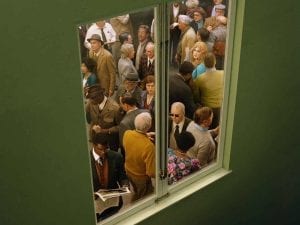Musical Thinking: New Video Art and Sonic Strategies is a ground-breaking new exhibition opening at Smithsonian American Art Museum (SAAM), Washington D.C. By bringing together photographs, sculptures, prints and immersive installations, the show explores the powerful resonances between video art and popular songs. In total, 10 of today’s leading contemporary artists – including ADÁL (1948-2020), Cauleen Smith (b. 1967) and Erin Ellen Kelly (b.1976) – will present their musical strategies and insights in 29 time-based artworks. Full of major new acquisitions, this show address personal experiences and shared aspects of contemporary life, exploring interconnected US identities and histories through rhythm.
The exhibition is organized by Saisha Grayson, Curator at SAAM since 2018, with support from Curatorial Assistant Anne Hyland. Grayson explains that music is “common ground”, an element “woven into our daily lives.” She states: “This is why SAAM’s first time-based media exhibition since 2015 is organized around this theme. The artists featured use audio to amplify aspects of American life to take on vast swaths of history and interrogate the country’s foundational constructs. The exhibition becomes an invitation to consider the relationship between the country’s past, present and future though this sonic frame.”

This idea is central to the moving-image of these 21st-century artists. They bring rhythmic thinking to their creative process – employing scores, thematic improvisation and performer interpretation – and to their selection of songs, styles and structures, often drawing from established traditions. Some turn to early spirituals or jazz whilst others reference mid-century musicals and even lullabies. Despite their varying influences, they all consider sound’s purpose and significance in daily life. Connecting innovative forms, past and present, they emphasise that the story of the USA has always been complex and multivocal.
For example, filmmaker Cauleen Smith uses visual and sonic elements to explore Afrofuturist possibilities in her film Sojourner (2018). Audiences explore what Grayson calls “self-liberating, community-building, utopian realities.” These principles are embodied by young women of colour who represent a future generation, as they traverse the desert landscape carrying an old radio. The retro device channels voices from the past, such as Black Shaker eldress Rebecca Cox Jackson and composer, performer and swamini Alice Coltrane Turiyasangitananda (1937-2007). They read from the 1977 manifesto of the Combahee River Collective, an organization of Black and lesbian feminists “actively committed to struggling against racial, sexual, heterosexual and class oppression.” Voices from the past inspire and uplift the women who come after them – new possibilities are key. In a discussion with Grayson, she asks: “We only re-enact traumas, don’t we? We don’t re-enact prom night, or our favourite birthday. This is a problem — it doesn’t seem to fix things, it amplifies them. There’s gotta be something else, the after the trauma.”

Elsewhere, practitioners are concerned with highlighting ambiguous identities and different communities. Work from photographer, installation and performance artist ADÁL presents the culturally complex backgrounds of Puerto Ricans. Mimicking the official status of a passport, El Puerto Rican Passport, El Spirit Republic de Puerto Rico: Luciana Alexandra del Rio de la Serna (1994) shows a blurry portrait of the document-holder. Inside are the words: “It is the responsibilidad (responsibility)of the Passport Bearer to tomar riesgos (take risks), illuminate contemporary issues, cuestionar (question) cultural estéticas establecidas (established aesthetics) and desafiar (challenge) political views”. Alongside is a collaborative piece by filmmaker Mariam Ghani (b. 1978) and body based artist Erin Ellen Kelly. When the Spirits Moved Them, They Moved (2019) is set in Pleasant Hill, Kentucky’s Shaker Village, a nineteenth-century settlement where the preserved Shaker legacies are preserved. Officially called the United Society of Believers in Christ’s Second Appearing, the religious group can be traced back to 1747. They live communally and practice ecstatic worship, embracing celibacy, pacifism, equality of the sexes and anti-slavery. Movement, narrative and choreography reanimate the past, giving audiences the chance to step into a reflective historical space.

Musical Thinking is a fully accessible and inclusive exhibition emphasising the multi-sensory and social aspects of sound. Audio notes on the wall or open captions are included for each installation; QR codes offer videos with American Sign Language translation or written verbal descriptions and sensory maps welcome attendees at each entrance, helping everyone to navigate varying light intensities, sound and subject matter. The museum collaborated with Motion Light Lab at Gallaudet University in Washington, D.C., to develop layered experiences particularly accessible for Deaf and hard-of-hearing audiences, also available to all visitors. Benches in black box galleries conduct enhanced vibrations to allow guests to physically appreciate the unique soundtrack in each video. Elsewhere, the light-up, haptic dancefloor designed in conversation with artist Martine Gutierrez (b. 1989) encourages audiences to feel, see and participate in the experience she creates in her video artwork Clubbing (2012). Individual visitors are transformed into communities that move in sync around the galleries. As these artists show, sight and sound can immerse us in new experiences and distant pasts whilst helping us to envision possible futures.
SAAM, Musical Thinking: New Video Art and Sonic Strategies | 23 June 2023 – 29 Jan 2024
Words: Diana Bestwish Tetteh
Image Credits:
- Cauleen Smith, Sojourner, 2018, digital video, color, sound; 22:41 minutes, Smithsonian American Art Museum, Museum purchase made possible by the SJ Weiler Fund, 2020.54.1, © 2020, Cauleen Smith.
- Simone Leigh, Liz Magic Laser, Breakdown, 2011, single-channel digital video, color, sound; 09:00 minutes, Smithsonian American Art Museum, Museum purchase through the Samuel and Blanche Koffler Acquisition Fund, 2019.33.2, © 2011, Simone Leigh & Liz Magic Laser
- Cauleen Smith, Pilgrim, 2017, digital video, color, sound; 07:41 minutes, Smithsonian American Art Museum, Museum purchase made possible by the SJ Weiler Fund, 2020.54.2, © 2020, Cauleen Smith.
- Simone Leigh, Liz Magic Laser, Breakdown, 2011, single-channel digital video, color, sound; 09:00 minutes, Smithsonian American Art Museum, Museum purchase through the Samuel and Blanche Koffler Acquisition Fund, 2019.33.2, © 2011, Simone Leigh & Liz Magic Laser




